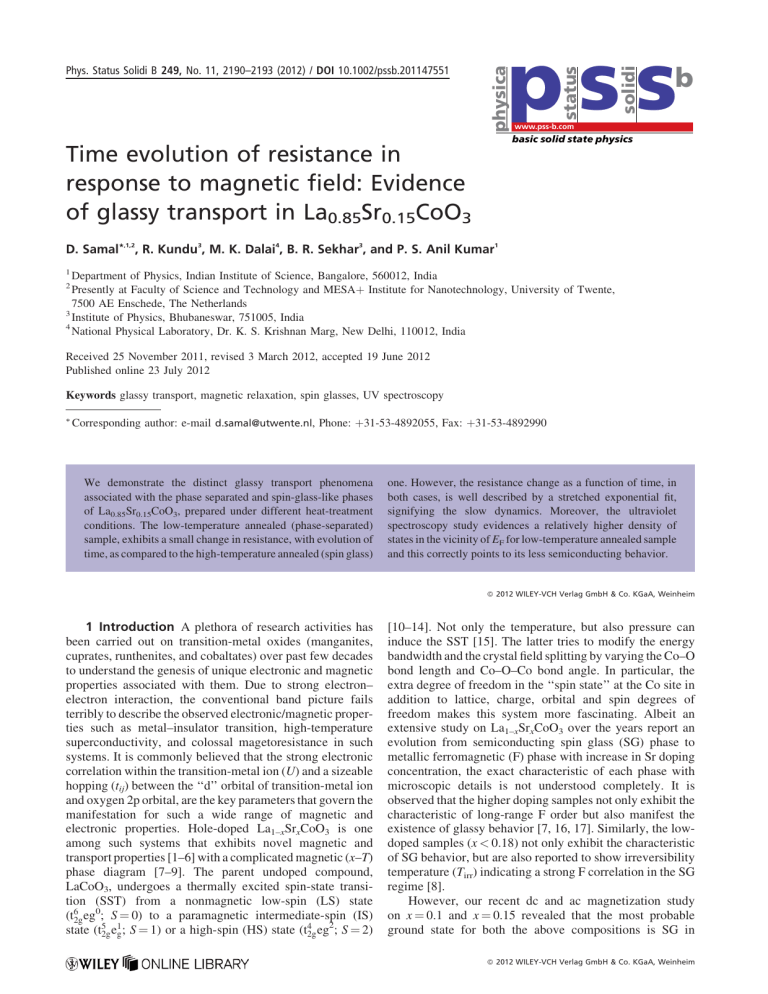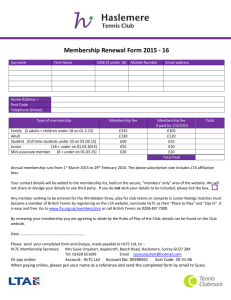Time evolution of resistance in response to magnetic field: Evidence Sr

Phys. Status Solidi B 249, No. 11, 2190–2193 (2012) / DOI 10.1002/pssb.201147551
p s s b www.pss-b.com
basic solid state physics
Time evolution of resistance in response to magnetic field: Evidence of glassy transport in La
0.85
Sr
0.15
CoO
3
D. Samal * , 1,2 , R. Kundu 3 , M. K. Dalai 4 , B. R. Sekhar 3 , and P. S. Anil Kumar 1
1
Department of Physics, Indian Institute of Science, Bangalore, 560012, India
2
Presently at Faculty of Science and Technology and MESA þ Institute for Nanotechnology, University of Twente,
7500 AE Enschede, The Netherlands
3
Institute of Physics, Bhubaneswar, 751005, India
4
National Physical Laboratory, Dr. K. S. Krishnan Marg, New Delhi, 110012, India
Received 25 November 2011, revised 3 March 2012, accepted 19 June 2012
Published online 23 July 2012
Keywords glassy transport, magnetic relaxation, spin glasses, UV spectroscopy
* Corresponding author: e-mail d.samal@utwente.nl
, Phone: þ 31-53-4892055, Fax: þ 31-53-4892990
We demonstrate the distinct glassy transport phenomena associated with the phase separated and spin-glass-like phases of La
0.85
Sr
0.15
CoO
3
, prepared under different heat-treatment conditions. The low-temperature annealed (phase-separated) sample, exhibits a small change in resistance, with evolution of time, as compared to the high-temperature annealed (spin glass) one. However, the resistance change as a function of time, in both cases, is well described by a stretched exponential fit, signifying the slow dynamics. Moreover, the ultraviolet spectroscopy study evidences a relatively higher density of states in the vicinity of E
F for low-temperature annealed sample and this correctly points to its less semiconducting behavior.
ß 2012 WILEY-VCH Verlag GmbH & Co. KGaA, Weinheim
1 Introduction A plethora of research activities has been carried out on transition-metal oxides (manganites, cuprates, runthenites, and cobaltates) over past few decades to understand the genesis of unique electronic and magnetic properties associated with them. Due to strong electron– electron interaction, the conventional band picture fails terribly to describe the observed electronic/magnetic properties such as metal–insulator transition, high-temperature superconductivity, and colossal magetoresistance in such systems. It is commonly believed that the strong electronic correlation within the transition-metal ion ( U ) and a sizeable hopping ( t ij
) between the ‘‘d’’ orbital of transition-metal ion and oxygen 2p orbital, are the key parameters that govern the manifestation for such a wide range of magnetic and electronic properties. Hole-doped La
1– x
Sr x
CoO
3 is one among such systems that exhibits novel magnetic and transport properties [1–6] with a complicated magnetic ( x – T ) phase diagram [7–9]. The parent undoped compound,
LaCoO
3
, undergoes a thermally excited spin-state transition (SST) from a nonmagnetic low-spin (LS) state
(t 6
2g eg
0 state (t
; S ¼ 0) to a paramagnetic intermediate-spin (IS)
5
2g e 1 g
; S ¼ 1) or a high-spin (HS) state (t 4
2g eg
2
; S ¼ 2)
[10–14]. Not only the temperature, but also pressure can induce the SST [15]. The latter tries to modify the energy bandwidth and the crystal field splitting by varying the Co–O bond length and Co–O–Co bond angle. In particular, the extra degree of freedom in the ‘‘spin state’’ at the Co site in addition to lattice, charge, orbital and spin degrees of freedom makes this system more fascinating. Albeit an extensive study on La
1– x
Sr x
CoO
3 over the years report an evolution from semiconducting spin glass (SG) phase to metallic ferromagnetic (F) phase with increase in Sr doping concentration, the exact characteristic of each phase with microscopic details is not understood completely. It is observed that the higher doping samples not only exhibit the characteristic of long-range F order but also manifest the existence of glassy behavior [7, 16, 17]. Similarly, the lowdoped samples ( x < 0.18) not only exhibit the characteristic of SG behavior, but are also reported to show irreversibility temperature ( T irr
) indicating a strong F correlation in the SG regime [8].
However, our recent dc and ac magnetization study on x ¼ 0.1 and x ¼ 0.15 revealed that the most probable ground state for both the above compositions is SG in
ß 2012 WILEY-VCH Verlag GmbH & Co. KGaA, Weinheim
Original
Paper
2191 Phys. Status Solidi B 249, No. 11 (2012) origin [7, 18, 19]. Moreover, our proposed phase diagram on
La
1– x
Sr x
CoO
3 clearly illustrates various probable magnetic phases associated with this system and hardly finds the presence of an irreversible line, which is believed to arise from F correlation existing in the spin-glass regime [7].
However, it was shown in our earlier report that one can prepare both phase-separated (that can exhibit irreversible temperature well above the freezing temperature) and SG compound for x ¼ 0.15, depending on the heat-treatment conditions and this has been rigorously discussed in
Refs. [18, 19]. In this manuscript, we have carried out a time-dependent transport and magnetization study (i.e. the time evolution of resistance/magnetization in response to a magnetic field), and the ultraviolet photoemission spectroscopy study to understand the distinct glassy and transport behavior associated with both phase-separated and SG-like phases of La
0.85
Sr
0.15
CoO
3
.
77 K
(a)
E
F
HTA
LTA
Diff
300 K
(b)
E
F
HTA
LTA
Diff
1 0
Binding energy (eV)
-1 1 0
Binding energy (eV)
-1
Figure 1 (online color at: www.pss-b.com) High-resolution photoemission spectra of the nearE
F and HTA La
0.85
Sr
0.15
CoO
3 region of the valence band of LTA samples at (a) 77 K and (b) 300 K. The difference spectrum (green) obtained by subtracting the spectra of
HTA from LTA and multiplied by 5 is also shown in the figure.
2 Sample preparation and characterization Two sets of polycrystalline La
0.85
S
0.15
CoO
3 samples were synthesized by a solid-state reaction method (with precursors
La
2
O
3
, Co
3
O
4
, and SrCO
3
) under two different heattreatment conditions. For the sake of brevity, the hightemperature annealed (1300 8 C) sample is abbreviated as
HTA and the low-temperature (1150 8 C) one as LTA. The details of the sample-preparation technique and crystallographic phase analysis by X-ray diffraction have been described elsewhere [18]. Magnetization measurements were made using a SQUID magnetometer. Electrical and magnetotransport properties were measured using a standard four-probe Van der Pauw configuration in a magnetic field up to 11 Tesla. All the magnetotransport studies were carried out with a configuration in which the current direction was perpendicular to the applied field direction. The ultraviolet photoemission spectroscopy study was performed by an
Omicron mu-metal ultrahigh-vacuum system equipped with a highly intense ultraviolet source (HIS 13) and a hemispherical electron energy analyzer (EA 125 HR). The photon flux from the He I (21.2 eV) source was of the order of
10
16 photons/s/sr with a beam spot of 2.5 mm diameter.
3 Results and discussion Our earlier study found that the LTA is less semiconducting than HTA. Besides,
LTA was found to show the signature of having a dominating ferromagnetic component along with a feeble glassy characteristic, unlike the distinct SG like phase with a freezing temperature ( T f
) 60 K as observed in HTA [18,
19]. In order to really understand why the LTA sample is less semiconducting compared to the HTA, we have undertaken the UPS study that aims to look at the density of states (DOS) near E
F for both the samples. In Fig. 1, we show the nearE
F region valence-band spectra at two different temperatures for both HTA and LTA, recorded with a higher resolution. The figure also shows the difference spectra obtained by subtracting the spectra of HTA from the spectra of LTA.
The difference spectra in Fig. 1a at 77 K, clearly suggest that the LTA has higher DOSs in the vicinity of E
F as compared to the HTA. The presence of more states near E
F in the case of
LTA explains why it shows higher conductivity as compared to the HTA in the low-temperature regime. However, the spectra collected at 300 K, for both LTA and HTA as shown in Fig. 1b, overlaps with each other, and we do not observe any such distinct feature in the difference curve. We conjecture at this moment that as the temperature increases, the ferromagnetic metallic regions present in the LTA tend to disappear, resulting in no enhancement of the DOSs in the vicinity of E
F
.
In order to get further insight into the underlying magnetic phases of both the samples, we have carried out transport and magnetic relaxation studies. Figure 2a and b demonstrates the resistive response to the application of a magnetic field with progress of time below T f
, for both HTA and LTA, respectively. In this mode of measurement, the sample is cooled from 300 K to the measuring temperatures
(i.e. 25, 35, and 50 K). Then, a 11 T field is applied and the resistive response is recorded with the progress of time. We observe a large negative change in resistance,
[ R ( t )– R (0)]/ R (0), of about 9–10%, with the evolution of time over a period of 10
4 s for HTA. However, the response for
LTA over the same period of time is found to be less (2%) as compared to the HTA. The time-dependent effects over a long period of time generally follow from the slow polarization of glassy phase. Since the LTA possess feeble
SG-like phase along with the predominantly ferromagnetic phase as demonstrated by the ac susceptibility measurements earlier [18], the time-dependent change in resistance is found to be less as compared to HTA. Various functional forms have been proposed to describe the time evolution of the response function ( f ( t )) in the glassy systems. One of the most popular relations is the stretched exponential
[20, 21] and given as f ð where t Þ ¼
A , B
A þ B exp ð t are constants, stretched exponent. Both
= t t t Þ b
; is the relaxation time and and b
(1) are related to the relaxation rate of glassy phase. The value of exponent b b is the depends on the www.pss-b.com
ß 2012 WILEY-VCH Verlag GmbH & Co. KGaA, Weinheim
2192 p s s b
D. Samal et al.: Time evolution of resistance in response to magnetic field
.
.
.
.
.
.
Figure 3 (online color at: www.pss-b.com) The magnetization decay with respect to time at 10 and 50 K. The solid lines are best fit according to the stretched exponential function.
Figure 2 (online color at: www.pss-b.com) Time-dependent resistance for (a) LTA and (b) HTA at 25, 35 and 50 K after applying
11 T magnetic fields. (c) Shows the same for HTA at 25 and 80 K after removing the field. The insets in (a) and (b) show the stretched exponential fits to R versus t data at 25 K.
nature of the energy barriers involved in the relaxation. For a uniform energy barrier, b ¼ 1 and for the systems with a distribution of energy barriers like SG materials, b lies in between 0 and 1.
The insets in Fig. 2a and b show the stretched exponential fits to one of the representative data set, R ( t ) versus t , collected at 25 K for both set of samples. It is found that the data fits reasonably well to the stretched exponential function with t ¼ 2138 s, b ¼ 0.66, and t ¼ 2092 s, b ¼ 0.95 for HTA and LTA, respectively. Figure 2c demonstrates the response to removal of the magnetic field below and above the T f for
HTA. Here, the sample is field cooled with 11 T from 300 K to the desired temperature of interest. Then, the field is switched off and the response is noted with progress of time. It is evident from Fig. 2c that after removal of the field, the HTA exhibits a time-dependent positive change in resistance and the time dependent effect disappear at 80 K, which is above T f
. In essence, the electronic transport response for both HTA and LTA to the magnetic field is time dependent and can be well understood considering the glassy physics.
We have also measured the time decay of magnetization for HTA at two different temperatures below T f
, using the experimental protocol as described below. First, the sample is field cooled with 100 Oe to the desired temperature below
T f
. Then, the field is turned off and the magnetization decay is recorded with the progress of time. Figure 3 shows the time decay of magnetization decay plotted on a semilogarithmic scale at two different temperatures. It is found that the magnetization decreases with increasing temperature sharply, very similar to what has been observed recently for SG-like La
0.7
Ca
0.3
Mn
0.7
Fe
0.3
O
3 nano-particles [22]. The observed behavior can be understood unambiguously if one bears in mind the nonequilibrium metastable energy landscape of the SG system [23]. At higher temperature, when the field is turned off, the thermal fluctuation causes the various energy barriers to be surmounted i.e. local metastability is quickly removed, since the barrier heights are not too intimidating or large. Thus, the high temperature state will have an average lower magnetization. However, as we go towards lower temperature far away from the spin freezing temperature, the energy barriers separating different local magnetization minima tend to be very high. Thus, the thermal fluctuation fails to randomize the local magnetization to a larger extent and hence yields a higher magnetization. In order to understand the magnetization decay behavior with progress of time, we have fitted the M versus t plot with the stretched exponential form [20]; which is generally used to study the slow dynamics of various disordered/SG systems
M ð t Þ ¼ A þ B exp ð t = t Þ b
: (2)
The constants in Eq. (2) bear exactly the same meaning as described in Eq. (1). The value of fitting parameter t comes out to be 15,695 s and 3894 s and b to be 0.43 and 0.46
at 10 and 50 K, respectively. One must note from the above values that though the values of b obtained at different temperatures does not vary appreciably, the value of t varies drastically from a higher value at lower temperature to a lower value at higher temperature. This implies that the system relaxes faster due to vigorous thermal fluctuations as we increase the temperature.
ß 2012 WILEY-VCH Verlag GmbH & Co. KGaA, Weinheim www.pss-b.com
Original
Paper
2193 Phys. Status Solidi B 249, No. 11 (2012)
4 Conclusions The results presented here unambiguously discern different magnetic and electronic transport properties associated with the phase-separated and SG-like phases of La
0.85
Sr
0.15
CoO
3
, prepared under different heattreatment conditions. The UPS study finds a finite DOSs in the vicinity of E
F for the phase-separated one and this evidently explains the observed transport data, as to why the
LTA is less semiconducting as compared to HTA. The transport and magnetic responses obtained under various experimental conditions, as a function of time, is well described by a stretched exponential behavior, which is expected for glassy systems. A direct comparison of the transport relaxation study finds a relatively small change in resistive response with evolution of time for LTA as compared to HTA. The time evolution of the resistive response in LTA is believed to arise from the feeble SG-like phase that persists in addition to the dominating ferromagnetic phase. Further, the time evolution of the magnetization study on HTA, exhibits the typical slow relaxation characteristics, associated with SG systems.
References
[1] M. A. Senaris Rodriguez and J. B. Goodenough, J. Solid State
Chem.
118 , 323 (1995).
[2] P. Ravindran, H. Fjellvag, A. Kjekshus, P. Blaha, K. Schwarz, and J. Luitz, J. Appl. Phys.
91 , 291 (2002).
[3] S. Mukherjee, R. Ranganathan, P. S. Anil Kumar, and P. A.
Joy, Phys. Rev. B 54 , 9267 (1996).
[4] P. S. Anil Kumar, P. A. Joy, and S. K. Date, J. Phys.:
Condens. Matter 10 , L487 (1998).
[5] P. S. Anil Kumar, P. N. Santhosh, P. A. Joy, and S. K. Date,
J. Mater. Chem.
8 , 2245 (1998).
[6] P. Mandal, A. Hassen, and P. Choudhury, J. Appl. Phys.
100 ,
103912 (2006).
[7] D. Samal and P. S. Anil Kumar, J. Phys.: Condens. Matter 23 ,
016001 (2011).
[8] J. Wu and C. Leighton, Phys. Rev. B 67 , 174408
(2003).
[9] M. Itoh, I. Natori, S. Kubota, and K. Motoya, J. Phys. Soc.
Jpn.
63 , 1486 (1994).
[10] R. Eder, Phys. Rev. B 81 , 035101 (2010).
[11] M. W. Haverkort, Z. Hu, J. C. Cezar, T. Burnus, H. Hartmann,
M. Reuther, C. Zobel, T. Lorenz, A. Tanaka, N. B. Brookes,
H. H. Hsieh, H. J. Lin, C. T. Chen, and L. H. Tjeng, Phys.
Rev. Lett.
97 , 176405 (2006).
[12] T. Saitoh, T. Mizokawa, A. Fujimori, M. Abbate, Y. Takeda, and M. Takano, Phys. Rev. B 55 , 4257 (1997).
[13] S. Yamaguchi, Y. Okimoto, and Y. Tokura, Phys. Rev. B 55 ,
R8666 (1997).
[14] C. Zobel, M. Kriener, D. Bruns, J. Baier, M. Gruninger, T.
Lorenz, P. Reutler, and A. Revcolevschi, Phys. Rev. B 66 ,
020402R (2002).
[15] K. Mydeen, P. Mandal, D. Prabhakaran, and C. Q. Jin, Phys.
Rev. B 80 , 4257 (2009).
[16] D. N. H. Nam, K. Jonason, P. Nordblad, N. V. Khiem, and
N. H. Phuc, Phys. Rev. B 59 , 4189 (1999).
[17] Y. Tang, Y. Sun, and Z. Cheng, Phys. Rev. B 73 , 012409
(2006).
[18] D. Samal, C. Shivakumara, and P. S. Anil Kumar, J. Appl.
Phys.
106 , 123920 (2009).
[19] D. Samal, K. Balamurugan, C. Shivakumara, P. S. Anil, and
J. Kumar, Appl. Phys.
105 , 07E320 (2009).
[20] V. Markovich, I. Fita, A. Wisniewski, G. Jung, D.
Mogilyansky, R. Puzniak, L. Titelman, and G. Gorodetsky,
Phys. Rev. B 81 , 134440 (2010).
[21] J. Wu, H. Zheng, J. F. Mitchell, and C. Leighton, Phys. Rev. B
73 , 020404 (2006).
[22] M. Perovic, A. Mrakovic, V. Kusigerski, J. Blanusa, and
V. Spasojevic, Acta Phys. Polon. A 118 , 813 (2010).
[23] J. A. Mydosh, Spin Glasses: An Experimental Introduction
(Taylor & Francis, London, 1993), p. 235.
www.pss-b.com
ß 2012 WILEY-VCH Verlag GmbH & Co. KGaA, Weinheim




